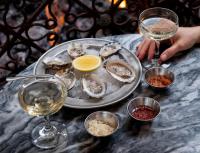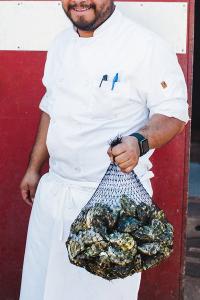What Henry’s Drinking: A Wine for Oyster Pairing

Oysters, in some ways, are similar to wine.
To some folks, maybe most, oysters all seem the same: they look similar, are all briny, and the taste is, well…oystery. But like wine, there is nuance and layering of flavors that require an open mind and the possibility of opening a world of discovery. I'm not pushing oysters on you. One likes them or they don't. For those that do, wine is an essential pairing, elevating, providing focus, and magnifying the experience.


The easy to get to and most classic wine partner for oysters is Muscadet. I've written about it before and surely will again. But let's use a wide angle lens for a bit and explore some additional options.

Alpine wines are having a moment these days and for good reason. Freshness and clarity replaced extraction and alcohol as the current vogue and these high altitude wines with their vibrancy and energy simply make sense. A great example of this style is 'Les 13 Lunes' Apremont from the Savoie region of France, made with Jacquere grapes in the sub-region of Apremont.
'Alpine' is used as a general term these days, referencing some wines that are nowhere near the Alps but exist under the same conditions, where high elevation and cool weather are juxtaposed against a short but consistently sunny growing season. It's this quality of sun that makes the development of crystalline and tightly wound fruit flavors possible with a ripe acidity and lively composition. This wine has only 10 degrees of alcohol, and by some textbook definitions of fine wine, this should not work; alcohol focuses all physical elements of wine and makes them compliant with one another. In this case however, the Alpine sun lends an exception to this rule. The fine-tuned and sturdy acid back-bone acts as a unifier of sorts combining a lean presence with incisive flavor. Oysters, you say?

The second wine for today is a sparkling Austrian rosé pét-nat, made with four native American grapes, one of which is Concord—the same grape we can find at our local farmer’s market. That's a bit outside the box even for me.
Let's back up a bit: There is a category of grapes in Austria named Uhudler. Folks cannot agree how this term actually originated. These are American grapes that were imported to fight the vine root destroying louse named phylloxera that decimated nearly all European vineyards in the late 19th century. Eventually it was discovered that grafting European grapes to American rootstock solved the issue, as American vines were impervious to the louse. To this day most European vines exist as grafts onto American roots. (USA!!! Whatever.)
In time, some of these rootstock/vine grafts actually started producing native American species of grapes instead of the valued European varieties— mostly in the Southern Burgenland region of Austria. These grapes made terrible wine…but their owners grew attached to them as one sometimes does to ignoble things. When the Austrian government tried to ban them, their owners fought back (this went back and forth and even today their future in this tiny region of Austria is in some doubt.) But thanks to climate change, these grapes and hence the wines are much better — the heat tempering their naturally high acidity and tangy, wild and aggressive savoriness. It's still a bit abrasive but in a confoundingly charming way.
The resulting wine is Weingut Schutzenhof Randale Pèt-Nat, a blend of Concord, Delaware, Elvira, and Ripatella grapes. This is an exciting wine for me. In a wine world that values new grapes and regions simply for their novelty, this happy accident actually has something unique to say. A perfect blend of savory wild berry juiciness with cooling herbs and firm textural minerality. A rare wine where texture and tension lead the flavor notes. The bone dry fruit plays a supporting role, especially with the bubbles present, making a unique and exciting pairing for oysters. Flavor notes are just flavor notes, but it's rare you find something that reorients the boundaries. The winemaker describes this here wine as "you can sleep with him and you can wake up with him." Different, aint it?

